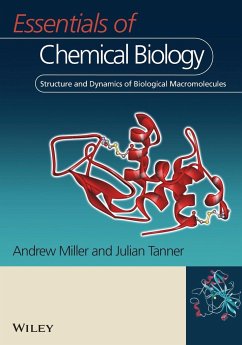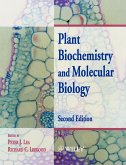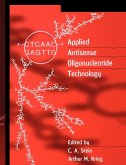Dem Grenzgebiet zwischen Chemie und Biologie ist dieser ausführliche, auf einem für Studenten geeigneten fachlichen Niveau verfasste Band gewidmet. Auf Vorkenntnissen aus dem physikochemischen Grundstudium aufbauend, erläutern die Autoren die Prinzipien, die der biologischen Funktionsweise von Molekülen zugrunde liegen. Didaktisch durchdachte Details -- typographisch abgesetzte Schlüsselkonzepte, viele durchgearbeitete Beispiele und Übungsaufgaben --, dazu zahlreiche, größtenteils farbige Illustrationen erleichtern das Verstehen und Vertiefen des Stoffs. Ein interaktiver Webserver stellt nützliche Links zu weiteren Informationsquellen zur Verfügung.
"This book seems to fit our needs very well, I would certainly recommend it. I would consider changing the course to reflect material in this book" Dr RJ Cox, University of Bristol.
" Worth pursuing as an excellent text for structural aspects. Would be very good for postgraduate courses as well" Dr N. Botting, University of St Andrews.
"Very much worth pursuing. The structure and dynamics approach is most welcome. The proposed text seems to address the omissions of several current texts. This could be the winner for our needs. A recent massive investment in bioinformatics and chemoinformatics means that modelling of structure (& recognition) and manipulation and visualisation of complex molecules is a real teaching possibility for evolving courses" Karl Hemming, University of Hertfordshire.
"Certainly there is a need for this type of text - its coverage is very comprehensive. A book like this would certainly allow development of existing courses or creation of new ones." Dr GA Nickolas, Manchester Met University.
"Will be a good new addition to current texts." DR J. Gardiner, UMIST.
"I find the overall philosophy and content of the proposed work both exciting and admirable. As far as I am aware, there is no book on the market with a similar coverage. I wish the authors well and think that this is a timely and worthwhile enterprise." (Dr. Brian Ridge, University of Exeter.)
" Worth pursuing as an excellent text for structural aspects. Would be very good for postgraduate courses as well" Dr N. Botting, University of St Andrews.
"Very much worth pursuing. The structure and dynamics approach is most welcome. The proposed text seems to address the omissions of several current texts. This could be the winner for our needs. A recent massive investment in bioinformatics and chemoinformatics means that modelling of structure (& recognition) and manipulation and visualisation of complex molecules is a real teaching possibility for evolving courses" Karl Hemming, University of Hertfordshire.
"Certainly there is a need for this type of text - its coverage is very comprehensive. A book like this would certainly allow development of existing courses or creation of new ones." Dr GA Nickolas, Manchester Met University.
"Will be a good new addition to current texts." DR J. Gardiner, UMIST.
"I find the overall philosophy and content of the proposed work both exciting and admirable. As far as I am aware, there is no book on the market with a similar coverage. I wish the authors well and think that this is a timely and worthwhile enterprise." (Dr. Brian Ridge, University of Exeter.)
"Essentials in Chemical Biology is a valuable resource not only for chemistry students who are venturing into and interested in biological systems, but also biochemistry and biology students who want a fundamental understanding of the physical and chemical basis of biology and the techniques used in its study." (Chemistry World, August 2009)
"The succinct and lucid presentation style of Essentials Of Chemical Biology will likely make it a popular resource for undergraduate and graduate students interested in the structure and interaction of biologically relevant macromolecules." (Journal of Chemical Biology, February 2009)
"This excellent work fills the need for an upper-level graduate course resource that examines the latest biochemical, biophysical, and molecular biological methods for analyzing the structures and physical properties of biomolecules. Miller (Imperial College London, UK) and Tanner (Univ. of Hong Kong) cover traditional subjects such as binding interactions and catalysis. They also describe biophysical theories and current methods for protein structure determinations such as circular dichroism, X-ray crystallography, neutron diffraction, NMR, EPR, fluorescence, mass spectrometry, and electron and atomic force microscopy. For example, the chapter on solution NMR provides simplified yet high-quality explanations of the key principles of NMR. The well-developed introduction helps students to better follow the more complex information concerning the principles of multidimensional NMR. In addition, the latter part of the chapter offers current applications using a variety of multidimensional NMR spectroscopy experiments in the analysis of proteins, nucleic acid, carbohydrate, and lipid structures. This reviewer showed Essentials of Chemical Biology to several of his senior graduate students, and they unanimously gave the book rave reviews. The work could be improved by better referencing the resource materials within the text and by providing student exercises at the end of each chapter." (J. M. Tomich, Kansas State University, Choice, February 2009)
"The succinct and lucid presentation style of Essentials Of Chemical Biology will likely make it a popular resource for undergraduate and graduate students interested in the structure and interaction of biologically relevant macromolecules." (Journal of Chemical Biology, February 2009)
"This excellent work fills the need for an upper-level graduate course resource that examines the latest biochemical, biophysical, and molecular biological methods for analyzing the structures and physical properties of biomolecules. Miller (Imperial College London, UK) and Tanner (Univ. of Hong Kong) cover traditional subjects such as binding interactions and catalysis. They also describe biophysical theories and current methods for protein structure determinations such as circular dichroism, X-ray crystallography, neutron diffraction, NMR, EPR, fluorescence, mass spectrometry, and electron and atomic force microscopy. For example, the chapter on solution NMR provides simplified yet high-quality explanations of the key principles of NMR. The well-developed introduction helps students to better follow the more complex information concerning the principles of multidimensional NMR. In addition, the latter part of the chapter offers current applications using a variety of multidimensional NMR spectroscopy experiments in the analysis of proteins, nucleic acid, carbohydrate, and lipid structures. This reviewer showed Essentials of Chemical Biology to several of his senior graduate students, and they unanimously gave the book rave reviews. The work could be improved by better referencing the resource materials within the text and by providing student exercises at the end of each chapter." (J. M. Tomich, Kansas State University, Choice, February 2009)








